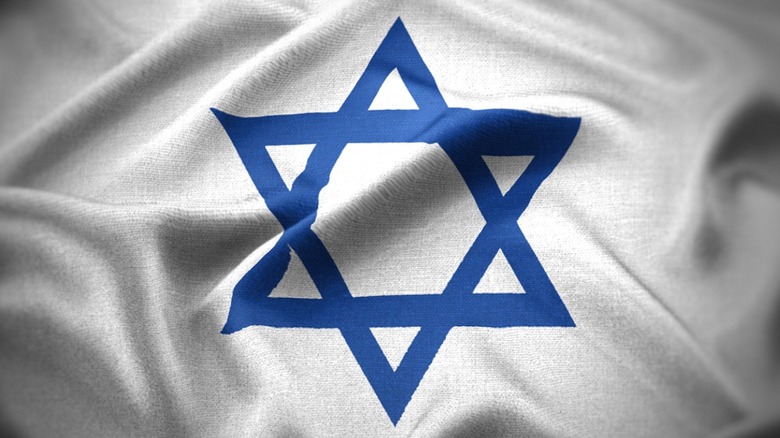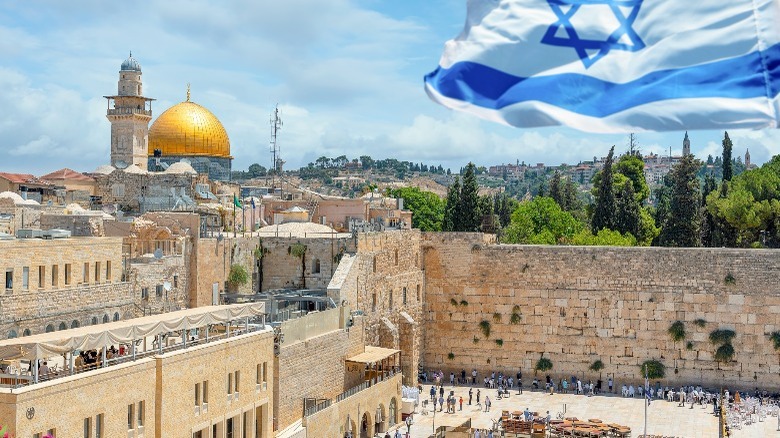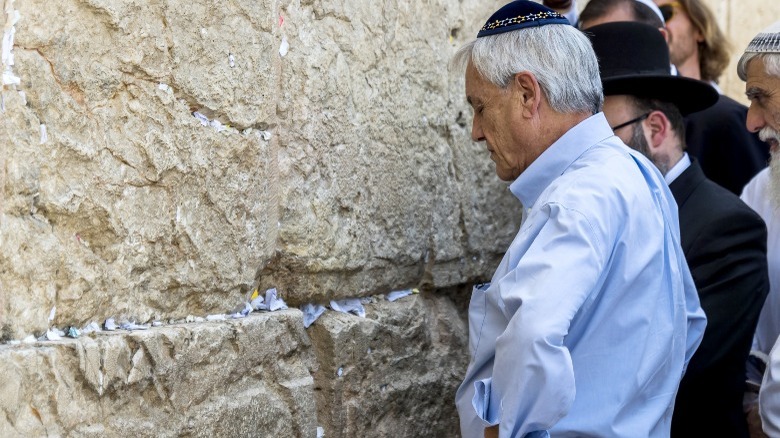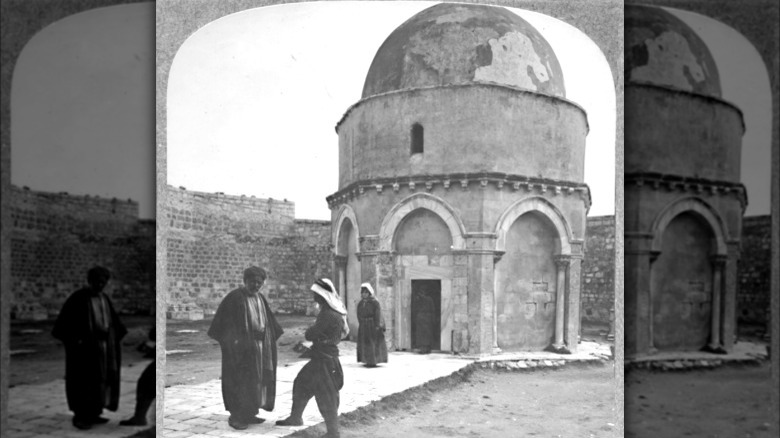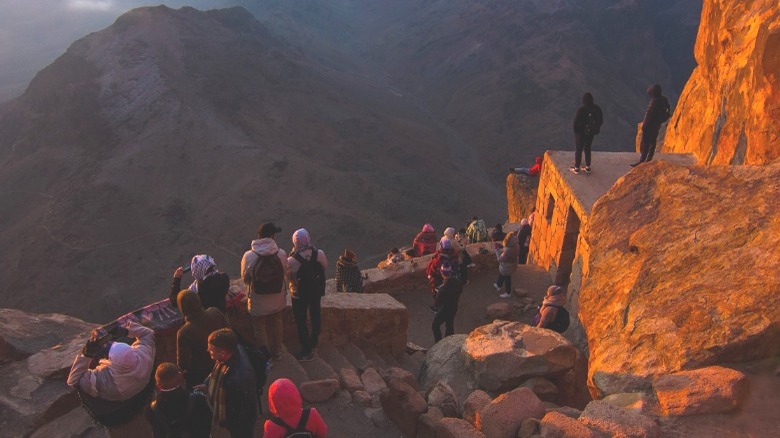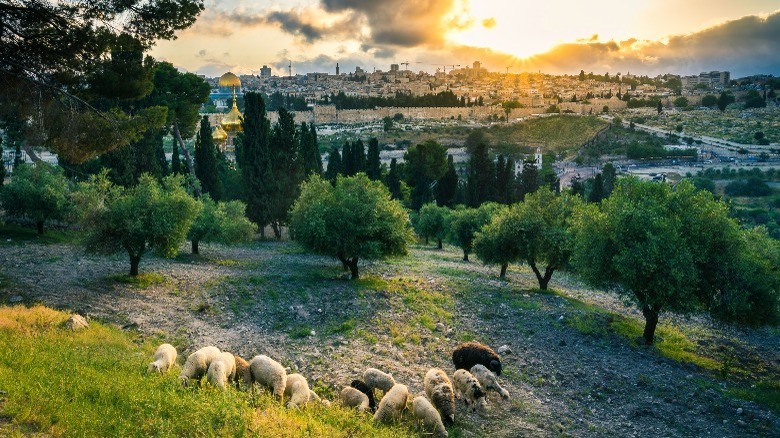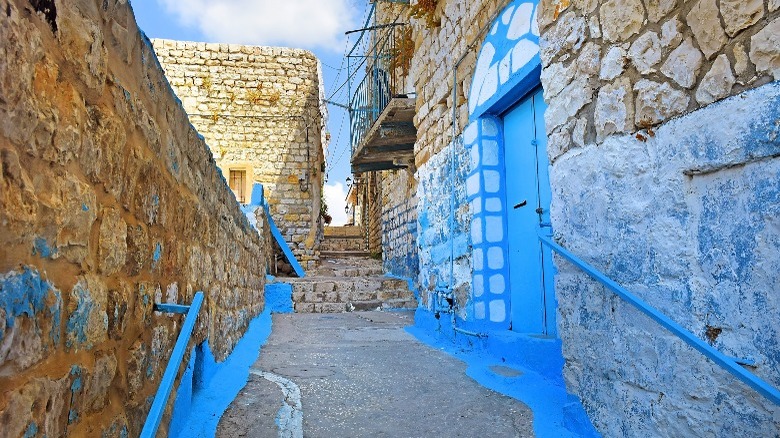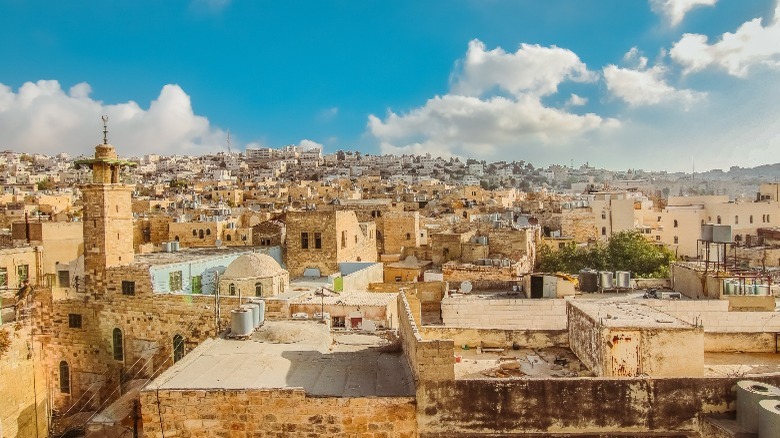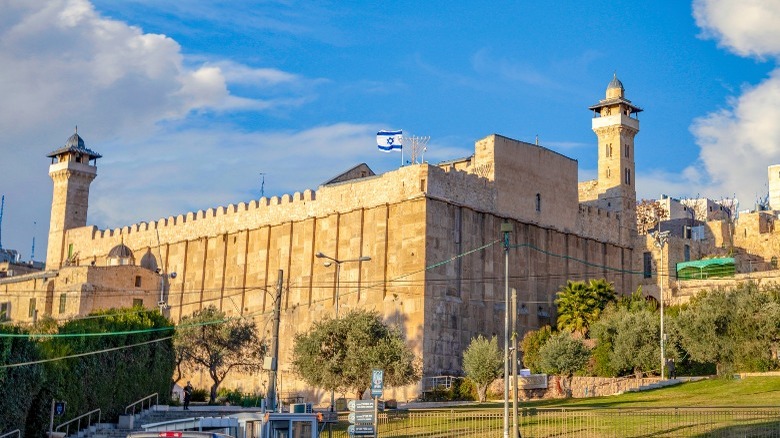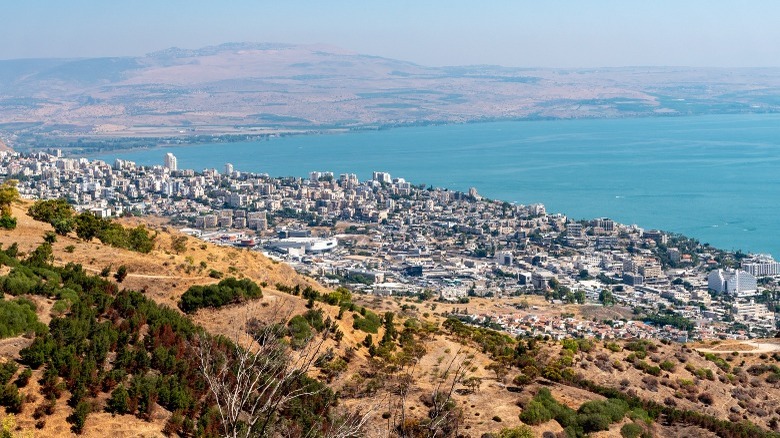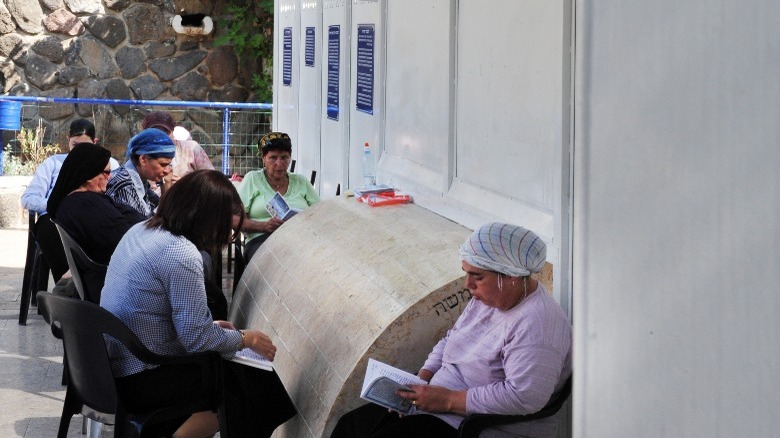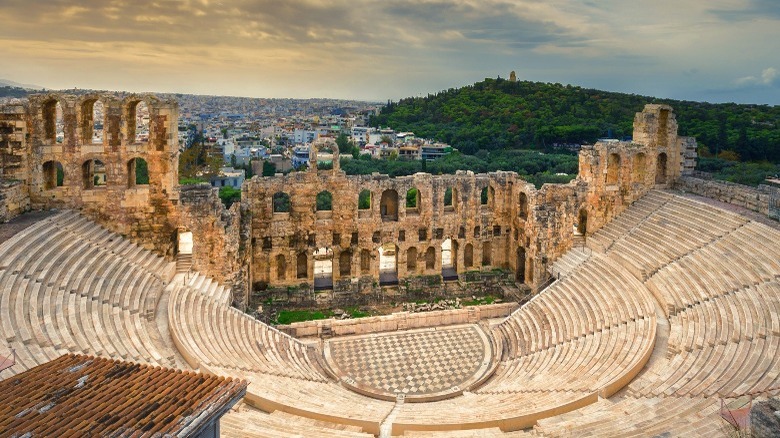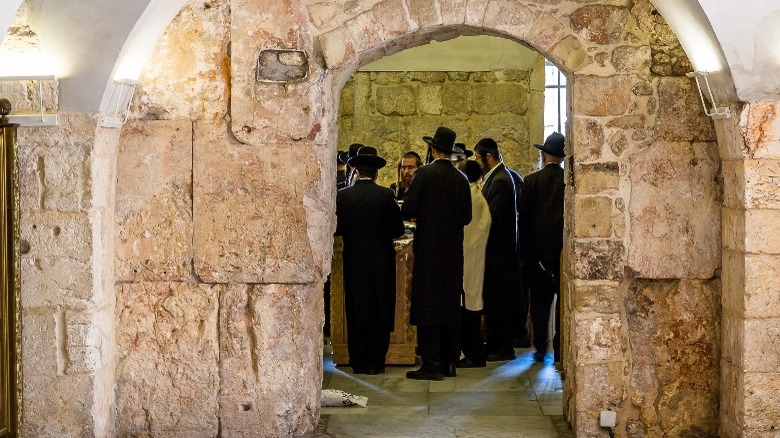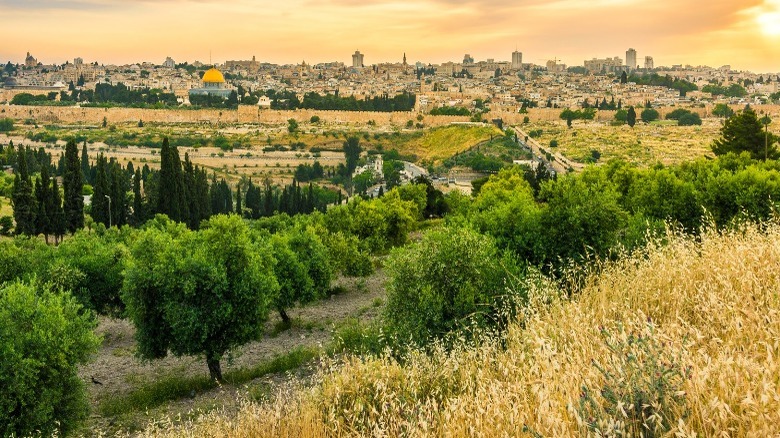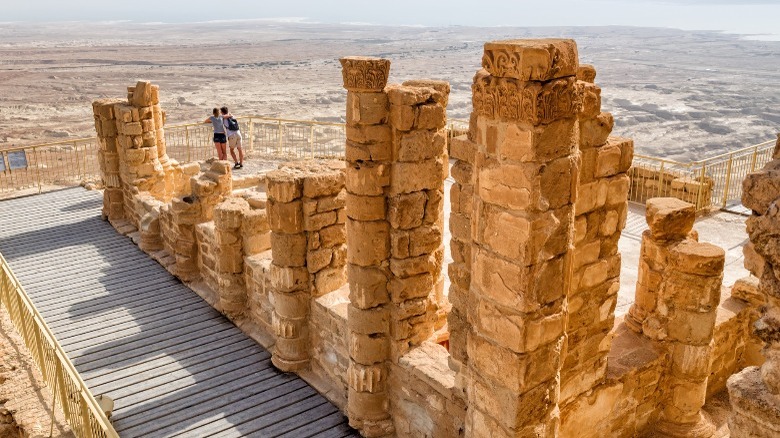The Holiest Sites In Judaism
Judaism is one of the oldest religions in the world with about 14 million followers today. According to History, it was founded almost four millennia ago when the Jewish patriarch Abraham received divine revelations from God. Abraham and God then entered into what became known as a covenant, where Abraham's descendants — the Jewish people — would be considered the chosen people and would prosper in exchange for their faith and obedience to God.
The central religious text in Judaism is called the Tanakh, of which the first five books are known as the Torah. There are also several different denominations of Judaism. Jews who strictly follow the Tanakh and Talmud (Jewish jurisprudence) are known as Orthodox Jews, but there are less strict movements like the Reform, Conservative, and Reconstruction denominations.
Throughout their 4,000-year history, the Jewish people have created countless monuments and temples throughout the world, though unfortunately many of them have since been destroyed. Additionally, many of their most sacred spots are also claimed in the name of faith by other Abrahamic religions like Christianity and Islam. Still, there are many surviving Jewish artifacts, especially in the Middle East. Let's take a look at some of the holiest sites in Judaism.
The Temple Mount in Jerusalem
In Judaism, the ancient Temple Mount in the Old City of Jerusalem is one of the most sacred and important places. According to Smithsonian Magazine, the mountain is revered for several reasons, some of them dating back to the beginning of biblical history. It is said to be the spot where God created the first human, Adam, and was the location of numerous other stories and events from the Torah involving Jewish patriarchs, like the story of Abraham and his son Isaac.
In 1,000 B.C.E., the Jewish King Solomon built the First Jewish Temple on the site of the Temple Mount, cementing its connection with Judaism. The temple was destroyed and subsequently rebuilt over the next 1,000 years before the Roman Jewish King Herod reconstructed the temple on the mountain in the first century B.C.E. The Temple Mount is also massively important to Muslims, as the site of the Dome of the Rock and al-Aqsa Mosque.
Today, all that remains at the Temple Mount are vague remnants from the Second Temple, which was destroyed almost immediately after Herod finished renovating it. The majority of the area is home to Islamic architecture and structures, but there are still many Jewish artifacts hidden in the soil of the Temple Mount. Unfortunately, tensions between Palestinians and Israelis have embroiled the mountain for the past century, creating both archeological and political conflicts. Still, historical research continues in the area today.
The Western or Wailing Wall
The remaining part of King Herod's Second Temple in the Old City of Jerusalem, dating to around the first century B.C.E., is known today as the Western Wall (or Wailing Wall). According to Britannica, the temple was originally constructed around the entire Temple Mount, but all that remains today is a portion of one of the retaining walls. Previously, the First Temple, built by King Solomon, had surrounded the mountain, but none of that is visible today (via Smithsonian Magazine). The Romans ultimately destroyed the Second Temple in 70 C.E., leaving only the partial wall remaining today. There is some archeological evidence to confirm the history of the wall, but the reason why it was not completely destroyed in 70 C.E. by the Romans is disputed.
Today, it is the site of daily prayers from Jewish people, who visit the wall and place prayers and blessings written on paper into its cracks and crevices. Due to its significance among Jewish worshippers and the emotionality of their prayers while at the wall, it has become known to some as the Wailing Wall — though some view this term as derisive.
Rachel's Tomb in Bethlehem
One of the most important matriarchs in Jewish history was Rachel, the wife of Jacob (Abraham's grandson), whose tomb is located in Bethlehem, Palestine. As "The New Encyclopedia of Judaism" explains, Rachel died while giving birth to her son Benjamin. She was buried in Bethlehem near the site of her death, and Jewish worshippers frequently visit her tomb as a pilgrimage. Rachel's popularity today is partly due to her significant presence in Jewish folk art, and also due to her struggles with infertility for much of her life. Eventually, Rachel was able to overcome her infertility and have multiple sons, and many women pray at her tomb to connect with her as a sign of respect.
As per the Jewish learning website Chabad, according to the Torah, Rachel was buried in Bethlehem for a special purpose. When her Jewish relatives were pushed out of Jerusalem following the destruction of King Solomon's temple, they passed by Rachel's tomb on their way into Babylonian exile. The tomb gave them courage on their journey, and Rachel's image was cemented within Jewish lore as a selfless figure who was willing to sacrifice herself for her people.
Mount Sinai in Egypt
Another of the most important and holy sites in Judaism is the famous Mount Sinai in Egypt. According to Jewish textual tradition, Mount Sinai is the spot where God first gave Moses the Ten Commandments and the Torah (via "The New Encyclopedia on Judaism"). Moses had just led the Israelites out of bondage from the Pharaoh by parting the Red Sea, and after they were wandering in the Egyptian desert they eventually ended up at Mount Sinai. Moses climbed up the mountain, received the word of God, and thus Judaism was officially born.
Today, the biblical Mount Sinai is associated with Mount Horeb, also known as Jebel Musa, on the Sinai Peninsula in Egypt. It is sacred not just for Jews, but also Muslims and Christians, who believe in the same Judeo-Christian origin story. The mountain is roughly 8,000 feet high and is currently administered by the Egyptian government (via Britannica). Identification of Jebel Musa with the biblical Mount Sinai is based partly on modern interpretations of the Israelites' biblical journey from Egypt to Israel. While it's impossible to positively identify the mountain purely based on biblical accounts, the association with Mount Horeb (or Jebel Musa) is widely accepted by most Jews, Muslims, and Christians.
The Mount of Olives holy cemetery
Sitting to the east of the Old City of Jerusalem in Israel is the sacred Har ha-Zetim, or Mount of Olives, which has a significant place in Jewish history. According to "The Oxford Dictionary of the Jewish Religion," it was previously connected to King Herod's Second Temple and has been a holy site for both Jews and Christians since ancient times. Though Jews have not always had access to the mount over the years, it has been a place of pilgrimage and celebration since the 10th century.
Per the Jewish Virtual Library, geographically speaking, the Mount of Olives serves as a barrier between the Judean Desert and the Old City of Jerusalem. The mount has also been a cemetery for the last 3,000 years, and there are several biblical prophecies mentioning it. King David used the mountain as a place for prayer, and it was during his reign that it started to be used as a cemetery. There are four major burial locations for the cemetery, and by 1948 there were already 60,000 graves on the mountain. Some of the tombs contain Israeli military veterans, as well as former Israeli prime ministers like Menachem Begin.
The holy city of Safed
Most people may not know that there are actually four holy Jewish cities, and one of them is Safed in the Galilee region of Israel. As "The Oxford Dictionary of the Jewish Religion" points out, though it was not mentioned in the Bible, it has had a stable Jewish community since the 13th century. Starting around the 16th century, Safed became synonymous with Jewish spiritual and literary activity.
One of the most important developments in Judaism happened in Safed in the 16th century, which was the creation of Kabbalah. According to the "Encyclopedia of Judaism," Moses Cordovero and Isaac Luria founded Kabbalah in Safed. Kabbalah is a denomination of Judaism considered Jewish mysticism and was eventually an important influence on the development of modern Judaism — especially among Hasidic Jews.
There are several ancient synagogues in Safed that can be seen and visited today, including one dated to be 1,700 years old (per the Jewish Virtual Library). The Meron village and mountain in Safed are both frequent places of Jewish pilgrimage, and it is the highest-elevation town in Israel.
The Old City of Hebron
Another one of the four holy cities in Judaism is Hebron, which is just to the southwest of Jerusalem. As Britannica explains, Hebron was an important biblical city and is connected with several Jewish patriarchs, including Abraham and David. Hebron is also a sacred city in the Islamic tradition, too, and it is said to have been the home of Abraham. It is the city where King David was crowned as King of Israel, and King Herod also contributed architecture to the city, which still partially stands today.
In modern history, it is a popular destination for Jewish pilgrimage, and it is also a bustling center of commerce for leather, glass, and agricultural products. There are several ancient Jewish artifacts and monuments in Hebron, including the Cave of the Patriarchs, which houses Abraham's tomb. Unfortunately, modern politics have at times gotten in the way of religious worship in Hebron, including deadly riots in the 1920s and the Six-Day War in 1967. But in 2017, UNESCO declared the city a World Heritage site due to its immense historical and cultural significance (via the BBC).
The Cave of the Patriarchs
Inside the holy Old City of Hebron lies the sacred Cave of the Patriarchs. According to "Pilgrimage: From the Ganges to Graceland: An Encyclopedia," the Cave of the Patriarchs, also known as the Cave of Machpelah, is home to the tombs of Jewish patriarchs Abraham, Isaac, and Jacob, as well as their wives, the Jewish matriarchs Sarah, Rebecca, and Leah. The cave is thought to be named Machpelah because the couples are buried together, and "machpelah" means "double" in Hebrew.
King Herod built the original structure around the Cave of the Patriarchs during his reign in the first century. There are also ancient Christian and Islamic structures, too, because Abraham is also the patriarch of Islam and Christianity. The cave has long been a pilgrimage site for Jewish visitors, even though they have not always been allowed access to it for prayer.
In 1994, the cave was the site of horrifying violence at the hands of an American-born Jew who had immigrated to Israel named Baruch Goldman. Goldman murdered 29 Muslims at the cave who were in the middle of praying, setting off a wave of violent riots which killed 30 additional Palestinians. Currently, the Palestinian Authority is in charge of Machpelah's administration.
The holy city of Tiberias
Along with Hebron, Jerusalem, and Safed, the fourth holy city of Judaism is Tiberias. According to "The Oxford Dictionary of the Jewish Religion," Tiberias has been an important Jewish town for thousands of years, dating back to the time of the Mishna. Many leading Jewish religious scholars and rabbis of the time lived in Tiberias, including R. Yehuda II. Arabs took over the city following the birth of Islam in the seventh century, and though there were consistently small areas of Jewish settlement, it wasn't until the late 18th century that a permanent Jewish community was again established in Tiberias.
As per Britannica, both the Mishna and Talmud were partly edited in Tiberias, and the city contains many ancient tombs and artifacts. Jewish sages Maimonides, Yoḥanan ben Zakkai, and Akiba ben Joseph are all buried within the city limits. Today, roughly 40,000 people live in Tiberias, which was also the site of many of the first Zionist settlers to arrive in Palestine in the late 18th and early 19th centuries (via the Jewish Virtual Library).
The Tomb of Maimonides
The Tomb of (Moses) Maimonides is one of the most important and sacred places in the entire holy city of Tiberias. Maimonides was born in Cordoba, Spain in the 1130s, and was a philosopher, scholar, and physician (per "The New Encyclopedia of Judaism"). He was an incredibly important philosopher in the tradition of Halakhah, and his book, "Mishna Torah" ("The Second Torah"), is a landmark work in Halakhah theology. He traveled from Cordoba to Fez in North Africa, before venturing on to Israel, and finally ending up in the Old City of Cairo (Fustat), in Egypt.
Maimonides was somewhat controversial during his time, too, because of his use of Islamic models in his commentary on the Torah (via Oliver Leaman in "Moses Maimonides"). Still, he was incredibly important in the evolution of jurisprudence surrounding the Oral Law of the Talmud. Though he died in Egypt, Maimonides was buried in Tiberias (via Britannica). His gravesite has been a place of Jewish pilgrimage since his death in the early 13th century.
King Herod's fortress at Herodium
The ancient Jewish King Herod left many important monuments from his reign that are still around today, including the famous site of Herodium in Israel. According to the Smithsonian Magazine, after becoming the King of Judea, Herod began construction on Herodium as a retreat and eventual burial site for himself and his family. He later made Herodium his district capital and created an aqueduct to funnel water three and a half miles into the desert fortress. Herod had the mountain on which Herodium was built raised artificially by 65 feet, and oversaw the construction of his own mausoleum. Though he was called Herod the Great, he was actually a vicious and bloodthirsty king; killing and torturing members of his own family indiscriminately.
In 2007, remnants of what were believed to be the tombs of Herod and some of his family members were discovered on the mountain. Also uncovered at Herodium were signs of an ancient theater that could accommodate up to 750 people, which was adorned with wall mosaics resembling Italian stylings (per Science Daily).
King David's Tomb in Jerusalem
One of the most important patriarchs in Jewish history was King David, and his tomb in Jerusalem is considered a very holy and sacred site. Per the Jewish Virtual Library, King David was the ruler of a united Israel for 40 years, and he was originally buried in Jerusalem, which is also referred to as the City of David. During the second century Bar Kokha revolt, his tomb was destroyed, obscuring its original location in history.
During the Crusades, Mt. Zion in Jerusalem began to be associated with King David's tomb, a connection that has been accepted by Muslims, Jews, and Christians today. Following the Israeli War of Independence after the second world war, Israel gained administration of Mt. Zion and David's tomb. For the next nearly two decades, until the Six-Day War in 1967, Jewish worshippers visited David's tomb with increased regularity. This was because some of the most sacred Jewish sites in the Old City of Jerusalem were not accessible to Jews, and David's tomb was the closest holy location to the city.
The Old City of Jerusalem
Home to many of the most important Jewish artifacts and holy sites in the world, the city of Jerusalem is immensely important for Judaism. Though settlements range back 3,500 years in Jerusalem, it first came under Jewish administration during the reign of King David in the 10th century B.C.E. (via History). King Solomon, David's son, built the First Temple in Jerusalem in 960 B.C.E. After being destroyed, it was rebuilt by King Herod in the first century B.C.E., before being demolished again a few years later.
Among important Jewish sites in Jerusalem are the Temple Mount, the Western Wall, the Mount of Olives cemetery, and King David's tomb. It is also a very important city for Muslims and Christians, too. Jerusalem is one of the four holy cities of Judaism and is considered the "eternal capital of Israel" (per Chabad). Tens of thousands of Jews visit the city and its various landmarks each year, marking its importance within the Jewish community. The Old City of Jerusalem has been a UNESCO World Heritage site since 2000, due to its massive historical and religious significance.
King Herod's mausoleum at Masada
Another important Jewish holy area that is also recognized as a UNESCO World Heritage site is the ancient fortress of Masada. Masada is in Israel near the edge of the Judean desert, close to the Dead Sea (via History). It was one of the several fortresses built by King Herod during his reign and dates back to the first century B.C.E. There is said to be an older fortress on Masada from the Hasmonean era, but there is no definitive archeological evidence uncovered to support that.
During the Great Revolt of the Jews against the Romans in the first century C.E., a group of Jewish rebels, the Sicarii, took over Masada as a final stand. Although they were unable to fend them off, rather than succumbing to Roman rule, most of the Sicarii died by suicide in the fortress before it was overrun.
Masada was largely abandoned for over a millennia before renewed interest sprouted in the 19th century. It was formally excavated in the second half of the 20th century and is now a national park and UNESCO site. Masada is a popular site for Jewish pilgrims, and there are several ancient artifacts and monuments relating to the time of Herod's rule and the Great Revolt.
